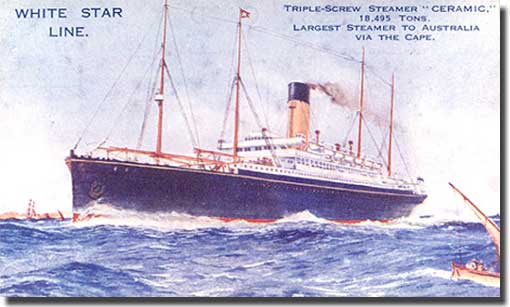SS Ceramic, a victim of U-515 on the 7th. of December 1942

Ceramic when sailing under White Star colours
Near misses by torpedoes.
Twice during WW1, the ship escaped being torpedoed, once in the Mediterranean in 1916, and a second time in 1917, in the English Channel.
Change of Ownership.
Cunard - White Star Ltd. was formed in 1934 to aid the Queen Mary project, and Shaw Saville and Albion acquired the Australian assets of the old White Star line, and these included Ceramic.
Reconstruction of the ship by her original builders.
In 1935, Harland and Wolff reconstructed this vessel, her new tonnage a shade heavier at 18,713 gross, and a slightly improved speed of 16 knots. The new design catered for 480 cabin class passengers, and her "Veranda Cafe" aft, dates from this rework.
WWII.
With the advent of WWII, the Ceramic once again donned Troopship colours, for service in that capacity out of Australia, but she still carried some passengers.
Collision.
On the 11th of August 1940 the ship was involved in a collision with SS Testbank, and was towed into Walwis Bay in SW Africa for temporary repairs.
Ceramic on a cigarette card.
On the 23rd of November 1942, Ceramic, under the command of Captain Elford, cleared the Mersey River at Liverpool, and set off for St. Helena, Durban, and Sydney. She had on board, 378 passengers, which included 12 children, 244 Naval/Military/Nursing personnel and 278 crew (in that number were 33 Australian seamen). In her holds were stowed 12,362 tons of general cargo and government stores.
That fateful day of the 7th of December 1942.
(NOTE: In England, the loss of Ceramic is recorded as the 6th of December 1942. It's reporting this loss by English time rather than the local time obtaining at the time which made the sinking on the 7th of December 1942.)
When steaming west of the Azores on the 7th of December 1942 the ship was sighted and then stalked by the German U-Boat U-515 (Captain Werner Henke). The weather was cold with rough seas. Henke struck with one torpedo about 8:00 p.m. Several minutes after this explosion, two more hits were made in the engine room.
The stricken ship stopped and darkness descended on board. 8 life boats, all crammed full, were lowered and got away from the sinking ship but she did not go down immediately. Just prior to midnight, two more torpedoes were released, to break the ship in two, and in another 10 seconds she was gone.
By now it was raining to make the life of the survivors even more miserable and the sea was very rough, with the life boats in danger of being swamped by the rising waves. By 8:00 a.m. the next morning, a Force 10 gale was blowing, and lifeboats were capsizing. Many of the survivors found themselves battling it out with huge seas, supported only by their life jackets.
About noon, the U-515 returned to the tragic scene and surfaced close to a group of survivors who thought rescue was at hand. Sadly no ... two German sailors threw a line to one man, Eric Monday of the Royal Engineers. He was hauled aboard to become a Prisoner of War and to be interrogated. He wound up in Stalag 8B in Upper Silesia, to remain imprisoned until his final release when WWII came to an end. Apparently U-Boat Command had ordered Henke to return to the scene of the sinking, in order to try and pick up the ship's captain to ascertain Ceramic's destination.
U-515 sailed away, leaving 655 of the ship's company to perish. Eric Monday her sole survivor.
Fate of U-515 and her Captain.
In April 1944, American warships caught up with and sank U-515. Captain Werner Henke, who had already sunk 26 ships, was shot two months later trying to escape from a prison camp in Virginia, though from the way he calmly started to climb the fence in broad daylight in full view of the guards and refuses an order to stop suggests that he was committing suicide to avoid being tried as a war criminal over the Ceramic disaster. Royal Engineer Eric Monday, the only passenger rescued from the sinking, would survive the war in a German POW camp.
Read article published about Werner Henke on AHOY.
Recording the names of those who perished in Ceramic.
All the Service personnel have their names recorded on the Brookwood War Memorial in Surrey England. The Civilian War Dead Register names all the civilian passengers. The Merchant Navy Personnel have their names recorded on the Tower Hill Memorial in London. The 33 Australian Seamen in Ceramic's crew are recorded on the Australian Merchant Seamen's Memorial in Canberra, Australian Capital Territory.
Click HERE for details of 656 people who were on board.
Click HERE for more photos.


No comments:
Post a Comment